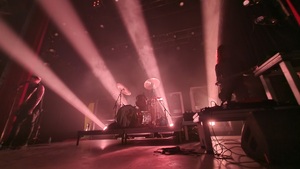Word Virus: The William S. Burroughs Reader
Edited by James Grauerholz and Ira Silverberg, with an introduction by Ann Douglas
New York: Grove Press 1998
I don’t think there is anything to be said about William S. Burroughs, good or bad, that has not been said before. He belongs on the short list of this century’s most important writers, and there may be no one else who did a better job of portraying the paranoia and brutality of post-WWII America.
The arrogant stupidity of man, which could once be written off as a series of individual psychoses, can not be ignored in the nuclear age. Indeed, the last 50+ years of history are rife with tales of our world in the balance, of mankind teetering atop the pointy heads of powerful men, whose common flaws and weaknesses (the sort of things we deal with daily, with little or no fanfare) are deadly serious when amplified by the bomb. To read Burroughs’ work is like viewing the long-term effects of atomic mutation on human communication. All the rules of grammar, sentence construction, punctuation, and narrative organization are systematically dismissed in order to arrive at a more direct means of transcribing thought. The 1960’s cut-up experiments with Brion Gysin helped illustrate the fragmentary nature of human perception, and WSB’s detatched outlook provided the perfect medium for exploiting these techniques. For my money (in this case, $27.50), WSB was the most complete writer of his time. By this I refer not so much to his subject matter as to his technical approach to writing. Most writers are intensely concerned, as they should be, with finding their own distinctive style; one that style has been codified, however, they tend to avoid variations (or, worse still, departures) from that ideal form. You can’t really blame them for not going further “out,” but it should be noted that, had anyone other than Burroughs written Naked Lunch , we would not be discussing them now. I think this point is best made in metaphorical terms, by comparing the fabled Beat Trinity with, for these purposes, their bop doppelgangers. As far as historical parallels, Kerouac was much like his hero, Charlie Parker: both were the driving forces of their respective movements, both possessed an artistic power superior to that of their colleagues, and both had an almost childish inability to deal with the fact of their own talent, which ultimately left them both as burnt-out husks of their former selves, creatively impotent, dead much too young. Now consider Ginsburg/Gillespie: both very talented, but less so than their afforementioned friends. Their personalities, and shall we say, greater emotional maturity, gave them greater staying power, and both lived to be old men. But they both reached a point where there wasn’t much new to be done artistically, and they spent their last couple of decades as cultural figureheads, good for name dropping but not especially relevant.
Now I don’t know who is truly the third corner of the bop pyramid; probably Monk, but he doesn’t fit the analogy. Burroughs, Ginsberg and Kerouac met at Columbia University in 1944. In terms of being ground zero for the events that followed, we can compare that to the Savoy Records session of 11/26/45, which featured Parker, Gillespie, and the guy that I’m equating with Burroughs, Miles Davis. The analogy doesn’t work perfectly: Davis was the youngest cat in his scene, whereas Burroughs was the oldest. But both were, at the outset, the least advanced of their group, but later became the dominant figures by combining longevity with a relentlessly evolutionary drive that paid off very well in their work. Unlike a lot of writers who become known for a particular work, one cannot read Naked Lunch , as brilliant and important as it is, and think that one has absorbed the essential nature of its author, though that is precisely the feeling one gets from reading Word Virus . Most “Reader”-type books read like rather expansive Cliff’s Notes, for even the most thoughtful, scholarly condensation puts too much emphasis on some things and too little on others. The editors of Word Virus , who assembled this compendium in time to receive Burroughs’ approval just a week before his death on August 2, 1997, did an excellent job of giving readers a balanced presentation of his work. The 532 pages of Word Virus are divided into eight chapters, each of which corresponds to a particular phase of Burroughs’ creative evolution. The editors’ biographical and epistemological commentaries preceding each chapter bring the contents into clearer focus by isolating recurrent themes in his work and their real-life motivations. Ann Douglas’ 13-page introduction puts the man in his proper historical perspective. There’s no point in elaborating any further; if you care, you’ll buy the book or rent it from the library.
The book also comes with a CD, on which Burroughs reads selections from the book, like “Twilight’s Last Gleamings,” “Roosevelt After Inauguration,” and “The Last Words of Hassan Sabbah.” Very cool stuff; it’s fun to read along with Burroughs’ voice, to note his cadences and accents. Unfortunately, the CD is only 22 minutes long, intended mainly as a promotional device for The Best of William Burroughs from Giorno Poetry Systems, a 4-CD box set of all Burroughs’ spoken-word performances. Consider it a bonus, because the book is well worth the cover price, even more so when it comes out in paperback sometime next century.
Grove Press, 841 Broadway, New York, NY 10003












